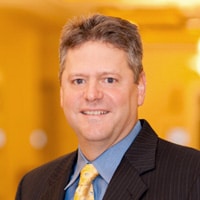Now chief information security officers can focus on true user identity management as well as some of the advanced innovations and analytics. They can collect real-time metrics and keep pace as the threats change over time.
David Wray
CTO, Public Sector, Micro Focus Government Solutions
Most of the questions I get today is around the integration of tools and how to do automation. What they should be asking is how do they drive value so they get adoption by teams for this enterprise service? We discovered you needed to have a service owner and a technical owner. The service owner was an evangelist for the developer to make sure the services are adding value.
David Wray
CTO, Public Sector, Micro Focus Government Solutions
Think of 2020 as the year of confluence.
Security, cloud migrations, application rationalization and the move to agile or a dev/sec/ops mindset have been part of federal IT modernization efforts for some time. But as the maturity of these efforts accelerate and the understanding of the customer experience increases, agencies are primed and ready to make digital transformation more than a bunch of one offs or talking points.
The Office of Management and Budget said as agencies move to the cloud, there are several things to consider:
- Agencies must assess the need for and usage of applications; and
- Agencies must discard obsolete, redundant or overly resource-intensive applications.
OMB says decreased application management responsibilities will free up agency workforces to focus on improving service delivery by optimizing their remaining applications.
At the same time, the growth and acceptance of robotics process automation (RPA) and other automation capabilities, for security as an example, are changing the way agencies work and helping them deal with threats at a speed that sometimes the workforce has trouble keeping up with.
David Wray, the public sector chief technology officer at Micro Focus Government Solutions, said one of the reasons the move the cloud is getting less daunting for many agencies is they finally have their heads wrapped around the security piece.
Wray said it’s not much that agencies have “solved” cloud security, but the now have tools to help them deal with data and threats in a much more predictive way.
The Homeland Security Department’s continuous diagnostics and mitigation (CDM) program is giving agencies the ability to use tools to do advanced analytics and correlation of data, machine learning and user behavior analytics.
“Now chief information security officers can focus on true user identity management as well as some of the advanced innovations and analytics,” Wray said on the Innovation in Government show. “They can collect real-time metrics and keep pace as the threats change over time.”
Wray said the cloud is helping agencies collect, store and analyze the cyber data.
“They are starting to investigate ways they can segment the event collection and actually correlate the events better to give them better analytics,” he said. “The other area I’m hearing a lot about is user behavior and event analytics, especially with the advancement in RPA.”
The data and cyber tools are but a piece of the larger cloud puzzle that agencies are putting together every year. Wray said the cloud smart strategy showed how the government has evolved its thinking from putting everything in the cloud to better understanding the total cost of ownership and mission value for any one application or system.
“With legacy applications, we’ve found there’s a huge return on investment by simply doing rehosting, which means not touching the legacy COBOL and rehosting in Linux in the cloud,” he said. “We’ve had some success in DoD and civilian agencies doing rehost where they can take advantage of the cloud and save tens of millions of dollars initially and then hopefully use that money to transform.”
Wray said Micro Focus Government Solutions developed a scoring approach to help agencies or any organization to make better decisions about whether to move an application to cloud.
“We have a questionnaire of about 150 different questions that allows you to describe the architecture, its footprint and the storage models,” he said. “It’s incredibly important to do those assessments first. With the legacy apps, I like the rehost model as the first step to free up some of the savings for transformation eventually.”
He said too often agencies didn’t understand the cost model to move older applications to the cloud so this assessment model will help with the pre-planning work.
Wray said moving to the cloud and improving cybersecurity are two legs of the three-legged transformation stool.
That third leg focuses on automation and delivery based on open standards to lower integration costs.
“When the government builds requirements, they can specify the measurement and data elements they want and any tool they purchase that conforms should easily align,” he said. “We have this in telecommunications, financial and other sectors. The interoperability plays a big part, especially with dev/ops.”
As part of this automation and integration, agencies need to be wary of the proliferation of tools that can also make transformation more difficult.
Wray said Micro Focus Government Solutions had this problem internally and ended up creating a software factory to standardize around 11 or 12 tools from more than 500 and created one set of development processes.
“I’m a little fearful of what some of the agencies are doing. They, more or less, are creating a supermarket of products. They really need to focus on one or two success stories of products and focus on developing these services,” he said. “Most of the questions I get today is around the integration of tools and how to do automation. What they should be asking is how do they drive value so they get adoption by teams for this enterprise service? We discovered you needed to have a service owner and a technical owner. The service owner was an evangelist for the developer to make sure the services are adding value.”
 About Micro Focus Government Solutions
About Micro Focus Government Solutions
Micro Focus Government Solutions is a U.S.-based purpose built, fully mitigated, independent, government compliant company serving the U.S. Public Sector. They are backed by one of the largest pure-play software companies in the world, Micro Focus. Micro Focus Government Solutions is committed to helping organization’s mission-critical IT challenges with their modern software solutions. Visit www.microfocusgov.com
Copyright
© 2025 Federal News Network. All rights reserved. This website is not intended for users located within the European Economic Area.










